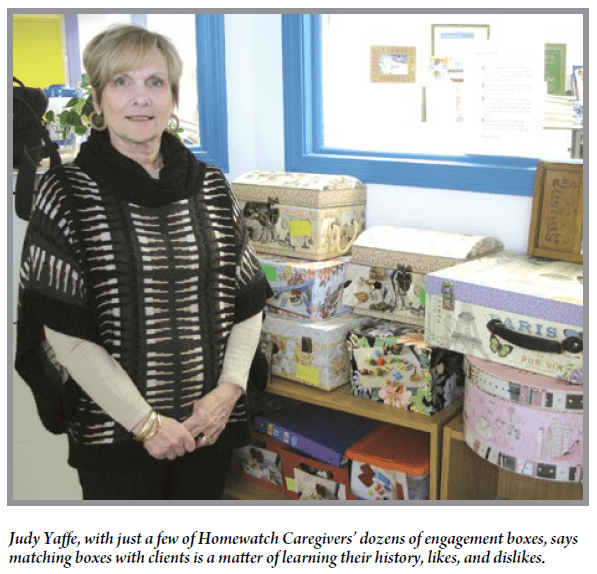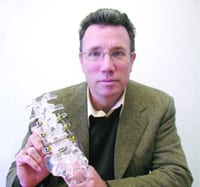Thinking Outside the Box – Innovative Method Helps Caregivers Engage with Clients with Dementia
As the over-65 generation is set to dramatically expand, so will the number of Americans suffering from Alzheimer’s disease and other forms of dementia. For those struggling with the cognitive and memory loss associated with these conditions, it’s beneficial to keep their minds active as much as possible. But how? Research by an intern at Homewatch Caregivers into a concept called ‘engagement boxes’ is setting a local standard for helping people with dementia hang on to memory, identity, and quality of life.
Christina Vernon calls it the “beach box.”
Inside are dozens of items that evoke the seashore — a jar of sand, a toy shovel and rake, a plastic bucket, a miniature beach ball, collections of seashells and sea glass, even a CD of beach-themed music.
To the average person, this array might evoke memories of a pleasant day soaking in the sun and the surf. But to someone suffering from dementia, the beach box may be nothing less than a catalyst for recovered memories and identity.
And it’s only one of dozens of such ‘engagement boxes’ that Vernon, a social-work student at Elms College, has carefully assembled for Homewatch Caregivers in West Springfield, where she works part-time, with the goal of focusing the minds of dementia patients through sensory stimulation and memory retention.
“These boxes hold items that trigger memories based on the five senses and promote conversation with people with dementia. It keeps them connected to conversation and lets them enjoy moments where they remember the past,” said Vernon.

For example, one brightly colored box might contain an old pair of white gloves, a child’s book of nursery rhymes, a small tea set, a beaded purse, and a jar of cold cream. “We might begin the activity by asking the client, ‘did you ever have a tea set?’ It may surprise you what your loved one comes out with.”
Sensory activities, she explained, involve many parts of the brain, including emotional, motor, and cognitive areas. They can allow someone with dementia to reawaken personal memories and help maintain the person’s quality of life, increase engagement with loved ones, and improve mood, behavior, and cognitive functions.
The key is to make sure the activities and conversations between caregiver and client are meaningful and individualized for each family.
“Nobody else is doing this, exactly,” said Judy Yaffe, co-owner of Homewatch Caregivers. “They’re very specialized for every client we’re working with. What happens is, we do a client history, get to know them a little more. We find out what they like and don’t like.”
Hence, the beach box would be ideal for a client who used to enjoy the beach or water activities. Other themed boxes contain baby-care items, art supplies, and vintage jewelry and toys — and Vernon often mixes and matches items to create individualized boxes to bring to clients. Caregivers engage the client with the items during visits, and, afterward, complete assessment sheets detailing what worked and what didn’t.
“The point of developing activities through the use of these boxes is to promote cognitive stimulation as an intervention for people with dementia,” Vernon said, noting that the roots of the philosophy can be traced back to 1950s research into ‘reality orientation,’ which was developed in response to confusion and disorientation in older patients in hospital settings.
Sensory exercises like the boxes Vernon maintains at Homewatch are coming more to the forefront in elder care as demographics are trending dramatically older. In short, Americans are living longer than ever before, with the massive Baby Boom generation heading into its golden years, and the number of patients with dementia — and, therefore, demand for services to assist them — are on the rise.
“Unfortunately, Alzheimer’s and dementia are going to increase,” Yaffe said. “We’re looking at a Baby Boomer tsunami.”
Engaging the Past
Engagement with dementia clients takes a variety of forms, Vernon said, showing off a pack of picture cards she uses during visits. She also shared a video of a session with a client in the early stages of dementia. Holding up a picture of stacks of coins,” she asks the client, “what is this?”
“It’s money.”
“Do you have money?”
“No.”
“Where is your money?”
“The children took it.”
“The children took it? How many children? A boy or a girl?”
“Girls. The girls took it.”
“The girls took it. Hmm,” Vernon says, while switching to a card with a picture of a game of jacks. “Did your girls ever like to play with these?”
And so on — each image, each conversation pathway leading to another cue to engage the client. The boxes Vernon has assembled takes the concept a step farther, by providing something to touch, feel, hear, even smell, in addition to viewing.
“She did this as a project for her school, an internship she developed,” Yaffe told HCN.
“I was responsible to do a full research project for the company I was interning for,” Vernon said, referring to Homewatch. “Basically, I found myself working with dementia clients. So I decided to do my research on sensory stimulation boxes and memory.”
She bought several boxes worth of items on her own to test the concept. “I visited clients daily with boxes and researched what worked and what didn’t work. At the end of 16 weeks, [Homewatch] offered me a position 10 hours a week to create this program and run with it. It’s been very exciting.”
Since then, Yaffe has purchased most of the items for subsequent boxes. They include a collection of vintage toys, like a yo-yo and an original Slinky; to a “baby box” ideal for clients who love children; and a box of clip-on earrings from the ’20s, ’30s, and ’40s, which Vernon brings to a client who loves jewelry. “I made it a game; I ask her to put the pairs together, and then ask if she wants to try them on. It just keeps her active.”
In addition to the boxes, Homewatch has a growing collection of books, DVDs, and CDs of various genres and topics, all aimed at helping clients with dementia keep their minds stimulated.
“The items aren’t always cheap,” Vernon said. “When I go out, I make sure the client has at least three options, and if those don’t work, I go back and find something that does work.”
Sometimes that involves a bit of role playing. “When you’re working with a dementia client, if you’re comfortable entering their world, it really works,” she said.
Yaffe agreed, noting that each client is at a different place in their disease progression and how far back their memories lie. “We’re looking at where they are in their dementia. It could be back to their childhood, could be back to their first job, and that’s where we go. Entering the client’s world, to us, is really important.”
For clients at less-advanced stages, the more hands-on the activity, the better. “One was an avid artist in sculpture, so we bring him books about sculpture,” Vernon said. “We’ve bought sketch pads and watercolor pastels, just things to keep his mind as active as possible.”
It’s all about giving caregivers tools they can work with, Yaffe said. “We’ve developed quite a library here.”
Peace of Mind
While researching the effectiveness of engagement boxes at an assisted-living facility, interviewing five people over a period of weeks, Vernon — who will graduate in May and go on to pursue her master’s degree at Springfield College — came to understand the detrimental effects of an inactive mind.
“When you’re bored, when you’re not doing anything, when a client is sitting idle, their memories are fading faster than when they’re engaged with someone,” she said. “It’s better for the client’s overall well-being to be engaged. It’s great to see people light up, to see people talk about things based on the items we take out. It’s rewarding work.”
Yaffe said eliminating isolation and loneliness are two of the goals of her agency, and the engagement boxes are now a major component of that — not to mention a practice that family members can continue after a professional caregiver has ended a shift.
“Activities bring pleasure to people with Alzheimer’s,” Vernon told HCN. “Keeping people involved in prior hobbies and interests that once gave them pleasure is important. Family members should take a flexible approach that is broad-based. Read the newspaper, look at books, cook, watch family videos — and remember to concentrate on the process of an activity and not the results. Perhaps develop your own engagement box for your loved one. It’s the joy of doing and discovery that can make the difference in their quality of life.”
Many clients don’t have dementia, but do suffer from some memory impairment, and the boxes — which can be checked out and brought back to Homewatch by families — can be effective tools for them as well.
“It’s really great for a family when they see mom or dad remembering something; it really gives the family a sense of purpose, as well as direction,” Vernon said. “We constantly exchange items and find out what’s working, find out what activities are good for a client.
“A lot of it is based on the individual person,” she continued. “I talk to the client and caregiver, spend an hour getting to know them, and after the initial meeting, I have a greater idea of what I can do to enhance their experience.”
Yaffe said Homewatch has long embraced other forms of sensory engagement with clients, especially music, which the Alzheimer’s Assoc. calls one of the main catalysts to recovering memory.
“We do a lot of music with our clients. If they remember something, it’s usually music from their teenage years, and they often remember it word for word,” she said. “It’s all about engaging people in the moment — but that moment can last the rest of the day for some people, and that’s important. It’s an easy activity if you can engage them.”
Added Vernon, “you see people light up when they hear their music. I think that’s an essential thing. That’s why most of our boxes have a CD with it. For the beach box, there’s beach-themed music. For the baby box, it’s lullabyes, softer music.”
Of course, she reiterated, the best boxes are the ones that engage all the senses. “It’s so worth the time and effort to make life better,” she said. “It works. We’ve validated it, and we know that it works.”



Comments are closed.